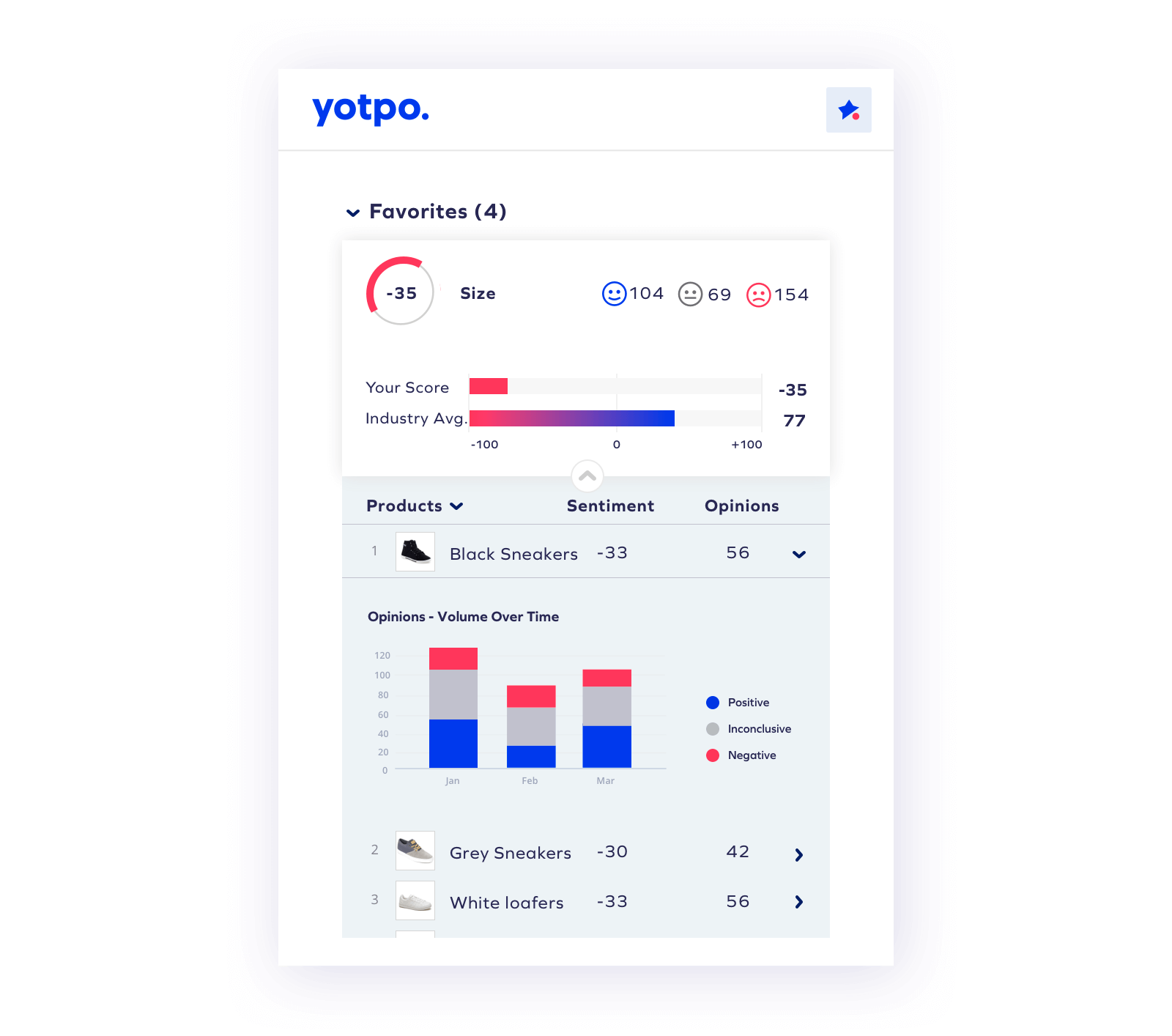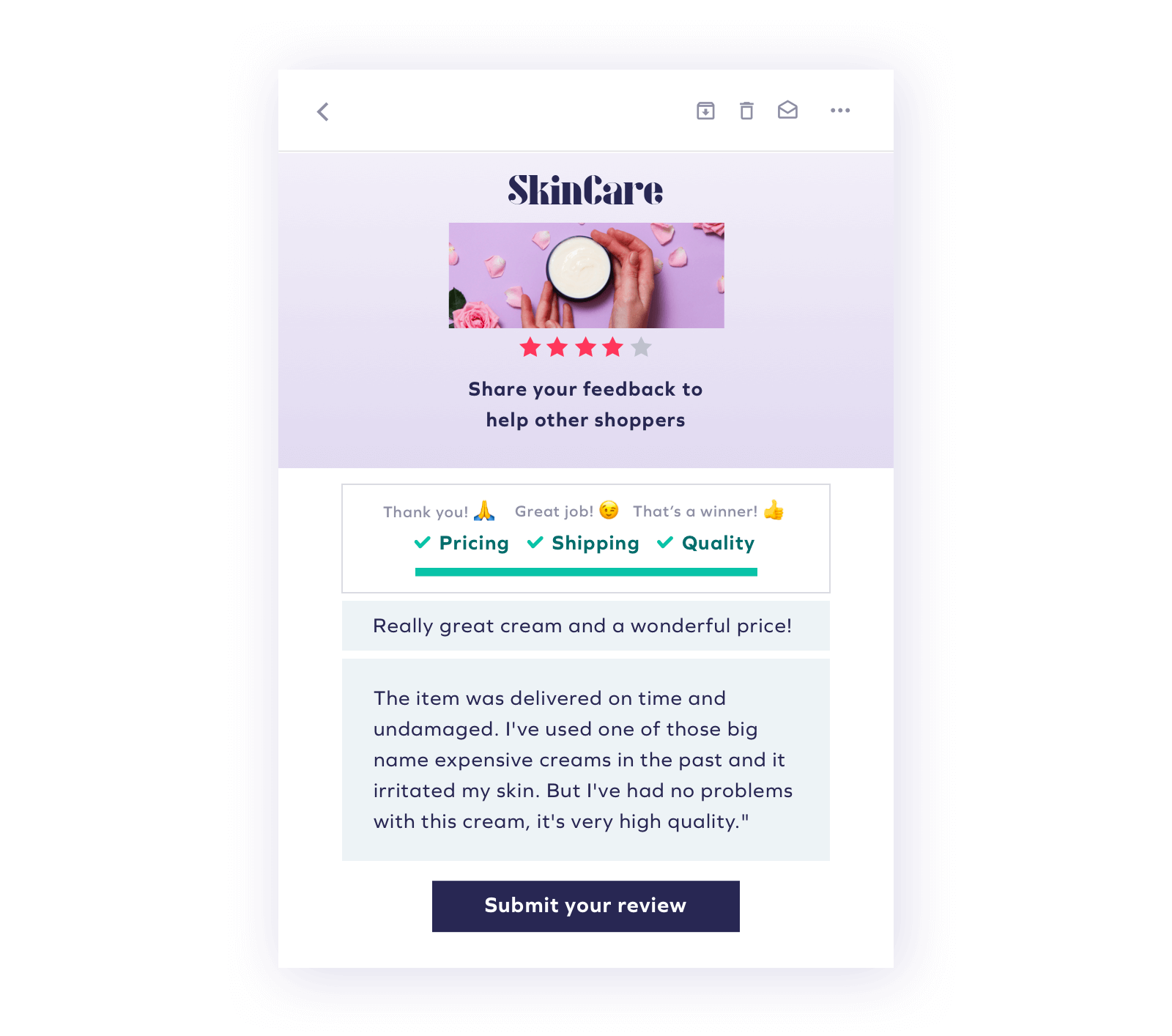Here are the benefits of reviews and net promoter scores, and how they differ from one another.
How do your eCommerce shoppers really feel about your brand and your products?
With sentiment analysis tools, you can identify what’s working well for your brand and where there’s room for improvement. Customer reviews and net promoter scores (NPS) provide an easy way for brands to gather feedback and measure customer sentiment.
But how do you know which tool is right for you?
Let’s take a look at what net promoter scores are, how they differ from reviews, and how reviews can provide more in-depth details about customer sentiment.
What are net promoter scores?
Net promoter scores are a type of metric used to gather feedback about the customer experience. This metric is calculated using one main question: How likely are you to recommend our brand/company to a friend or colleague? Sometimes the question may be rephrased to ask: How likely are you to recommend our product(s) to a friend or colleague?
From there, shoppers can choose a rating on a scale of one through 10 — one being “not likely at all” and 10 being “very likely.”
Detractors, passives, and promoters
Depending on how your brand or products are rated, your customers will be classified as one of the following:
- Detractors: These customers have a negative sentiment about your brand and/or products, and will most likely not be returning to your site.
- Passives: These customers enjoy your brand and/or products, but can easily be swayed if they find something they like better.
- Promoters: The promoters are your most loyal customers who will be eager to interact with your brand and visit your site again and again.
Calculating net promoter scores
To gather a complete view of customer sentiment for your brand and products, you’ll need to calculate your score. You can do this by gathering all of your responses and subtracting your percentage of detractors from your percentage of promoters.
Here’s what your net promoter score means:
- 0 to 30: Good, but there’s room for improvement.
- 30 and 70: Great, you’re consistent through and through.
- 70 to 100: Excellent, you’re going above and beyond.
Any net promoter scores that fall within the negative range could indicate that a lot of work is needed to change the overall sentiment about your brand.
NPS uses and benefits
Net promoter scores are often used among service providers to gauge how well they’ve performed from a customer experience standpoint. This can include businesses in the transportation, healthcare, financial services, and tech industries. However, even eCommerce brands are starting to see the value that NPS can provide. Some of these benefits include:
Quick and easy assessment
If you’re looking to get a quick snapshot of customer sentiment, NPS can help. This tool will allow you to gather feedback efficiently as it focuses on one core question that your customers can easily answer by selecting a number from a scale.
Measures customer loyalty
Shoppers who identify as “promoters” will be the ones returning to your site for repeat purchases. With NPS, you can see that very clearly with any shoppers who rate your brand at the higher end of the scale.
Allows for benchmarking
Brands can use NPS as a way to understand where they stand within their industry and among their competitors. For example, if the industry average net promoter score is 75 and your NPS is a 65, it may be time to implement some changes.
Where NPS falls short
While there are plenty of benefits that come with leveraging NPS to get quick answers when you need them, NPS doesn’t give you a complete picture. Net promoter scores fall short due to the following:
Lack of in-depth details
With NPS, brands receive a number rating that indicates whether or not their business is doing well; however, it does not provide details on what specifically is working or not working.
For instance, if a customer gives a hand soap a two or three NPS, what specifically did they not like? Was it the scent, consistency, or color of the hand soap? With no outlined areas for improvement, how can brands know what they should be focusing on to create a more positive sentiment?
Limited in approach
The main question that is asked in order to gather a net promoter score is whether or not the customer would recommend the brand or product to someone they know. But that’s usually the only information that is collected about the shopper and their experience.
Some brands may choose to ask follow up questions based on how a customer rated their experience with a particular brand or product. But in doing so, they may risk their shoppers moving on to something else — especially if the shoppers were under the impression that they would only have to select a number from a scale. Additionally, survey questions will not impact the overall score.
Less customer-facing
Net promoter scores are industry-facing ratings. Meaning, your competitors may be able to access your NPS, but the average customer searching for a new coffee table will not. Even if your shoppers did have easy access to your net promoter score, they may not understand what it means; therefore, NPS doesn’t impact the path to purchase as much as reviews do.
How Yotpo Reviews can fill the gaps
Reviews have the power to provide the kind of in-depth details that brands need in order to push forward and grow within their specific industries. The best part? Reviews are easily accessible to brands as well as their customers. Yotpo Reviews, in particular, can provide so many details about customer sentiment. Here are some Reviews features that help to collect customer feedback:
Insights
Analyze your customer feedback with Insights. See what your shoppers are saying and use it to make more informed decisions about your brand and products. With Insights, customer sentiment is measured for each topic and opinion using a Deep Learning statistical model that categorizes customer feedback as positive or negative. In a lot of ways, this feature works similarly to NPS where a total sentiment score must be calculated and ranges from -100 to +100.

This breakdown of positive and negative customer sentiment is specified by topic. And with Insights, Yotpo can provide a benchmark of how your brand is doing compared to others within your industry by comparing your brand to other Yotpo customers. Insights can also provide details about how location and time period have impacted the customer experience, and it allows you to track consumer trends over time.
Custom Questions
In addition to Insights, you can go beyond simple questions like “Would you recommend this product to a friend?” with Custom Questions. This feature gives brands the opportunity to ask more specific questions to understand whether a product shipped well and on time. It allows them to see if the shoes that a customer ordered fit too big or too small, or if the product was worth the amount that the customer paid.
Smart Prompts
Smart Prompts can suggest key converting topics for customers to write about while crafting their review. Depending on the product, brands can collect feedback about specific areas such as size, color, taste, smell, shipping, and so much more.

Plus, more than half of the consumers surveyed in the Yotpo Reviews Consumer Survey stated that writing prompts make it much easier for them to share their thoughts about products.
Photo and Video Review Request
Encourage the addition of photos and videos within your review requests. While a written review will point out what customers really enjoyed about a product and/or what they wished was different about a product, photos can act as another form of social proof. Visual elements such as photos and videos can also help to boost customer confidence in your brand, as the photos can easily be displayed within key areas on your site.
NPS vs. Yotpo Reviews: Which is right for your brand?
While net promoter scores provide a quick and easy way to understand whether or not your customers are happy, they don’t give you the full view. Aside from that, NPS is not as easily accessible to your shoppers as reviews are. Yotpo Reviews allows you to capture the kind of nuanced details that can help you identify areas of improvement and drive growth for your brand.
When determining which customer sentiment analysis tool is right for your needs, consider your industry as well as the kind of feedback that is most important to your business goals.
